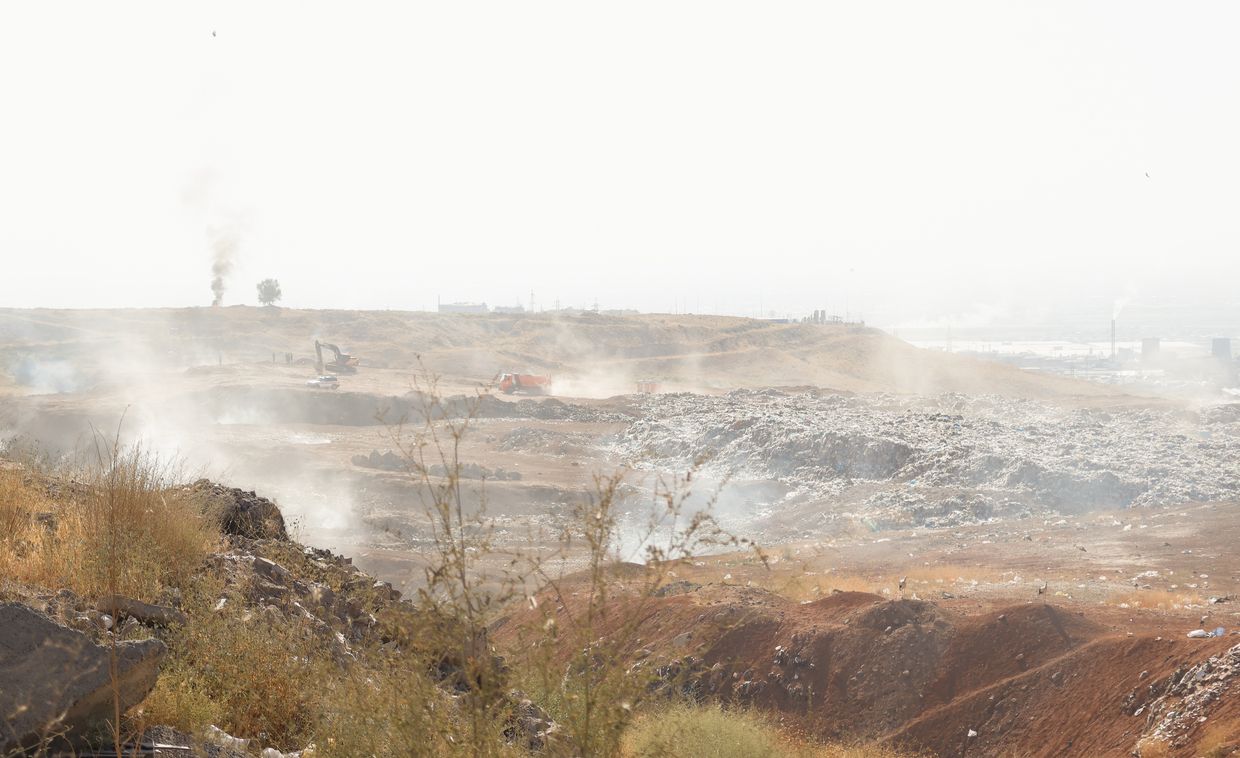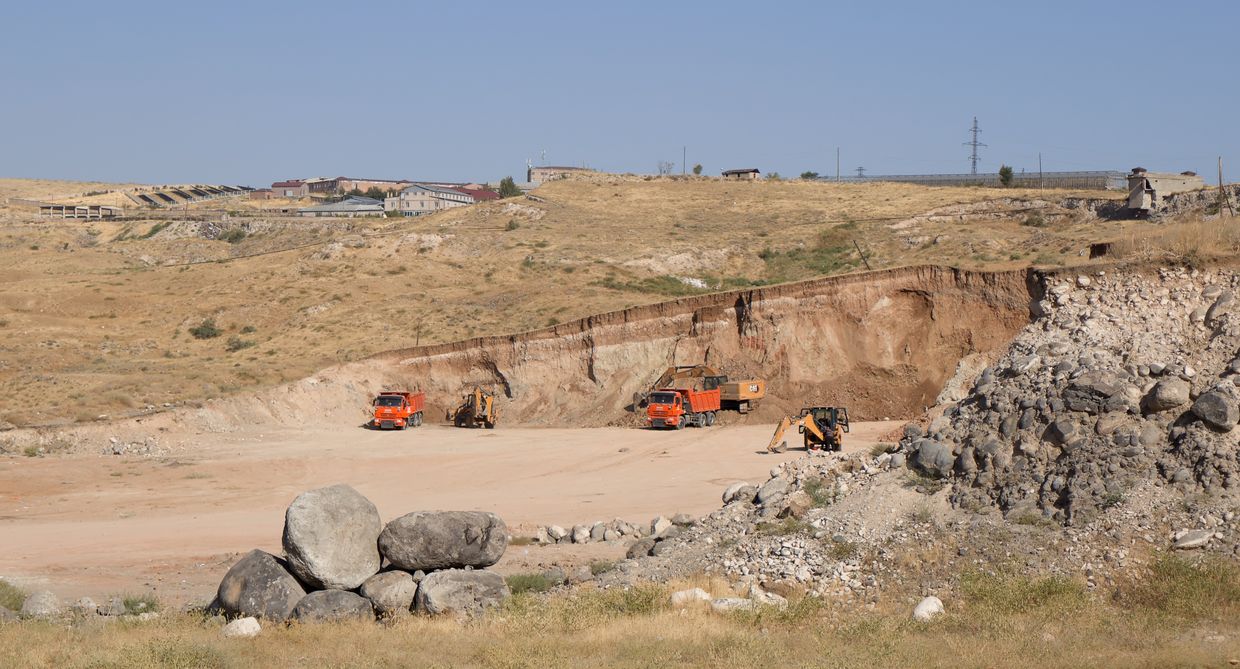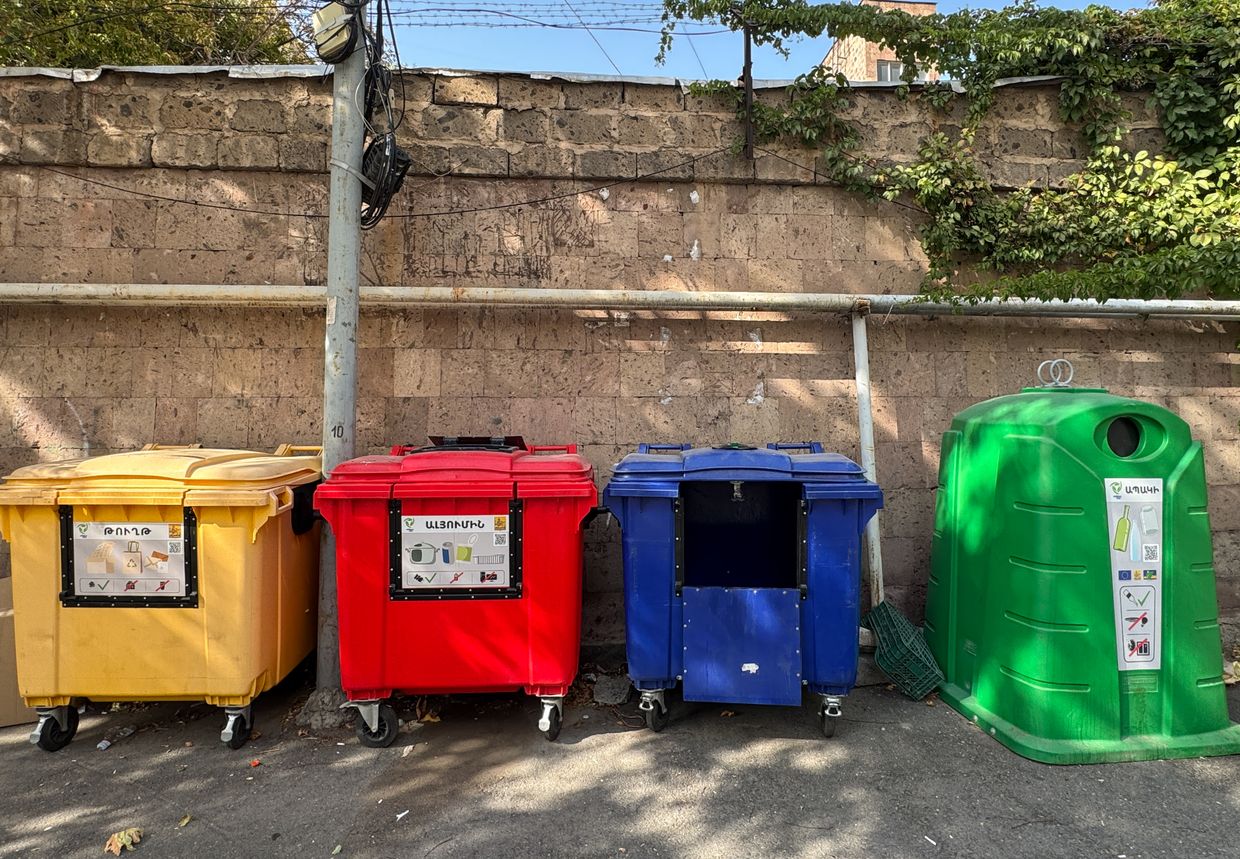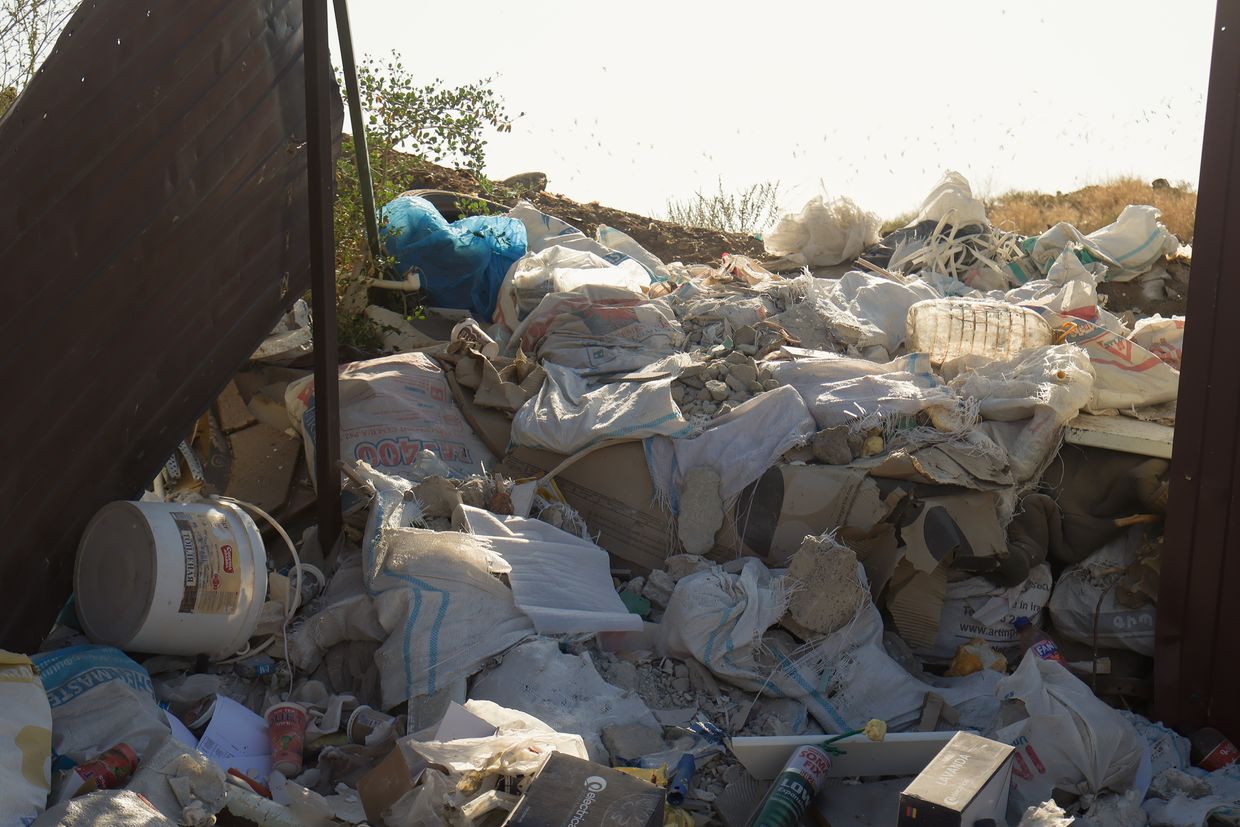As a child, Ani recalls playing outside in the evenings only to return home with red eyes from the toxic haze carried by the wind from the nearby burning landfill. A resident of Nubarashen, an outlying district in the south of Yerevan, Ani, now 28, says she has lost count of the times she has struggled to breathe through the fumes from fires burning at the Nubarashen landfill.
The most recent blaze, on 8 August, blanketed the neighbourhood in a smog that spread across surrounding areas, from Erebuni to downtown Yerevan. It reeked of smouldering plastic and chemicals for several days.
‘I felt a burning in my chest’, Ani tells OC Media. ‘My sister’s four-month-old baby was coughing’.

Established in the 1950s without a permit, Nubarashen is Armenia’s largest open-air dump, receiving nearly all of Yerevan’s municipal waste. Unregulated and hazardous, it has long been prone to fires sparked by human activity and trapped greenhouse gases.
In the aftermath of the August fire, Yerevan Mayor Tigran Avinyan announced plans to replace the Nubarashen dump with Armenia’s first modern waste processing plant through a public-private partnership. On 18 August, he instructed city hall officials to organise a two-stage tender by the end of the year, threatening that ‘relevant personnel decisions’ would be made if deadlines were missed. Yet no details have been given on how the project will be implemented or when it might be completed.
Many local residents and environmentalists say they’ve heard the same promises before. For more than two decades, successive governments and city officials have vowed to close or modernise the site, while people continue to live with its health and environmental toll.
Failed attempts to close Yerevan’s ‘toxic bomb’
The last attempt to reform the landfill came via the 2015 Yerevan Solid Waste Project, backed by grants from the European Bank for Reconstruction and Development (EBRD), European Investment Bank (EIB), and the EU. It aimed to build a new regional landfill in the Nubarashen district and to close the existing Nubarashen and Ajapnyak dumpsites, at an estimated cost of €26 million ($30 million), But after nearly 10 years of inaction, Avinyan announced in July 2024 that the plan had been cancelled.
‘Our municipality said they shut down the European Bank programme because no company would take part in the tender’, Inga Zarafyan, the president of EcoLur, a local green advocacy group tells OC Media. ‘This is the first time I’ve heard that companies around the world cannot make a profit from garbage’, she says.
Zarafyan has been attempting to raise awareness of the landfill’s hazards for 15 years. ‘We need clear and strict measures to neutralise this toxic bomb we’re sitting on’, she continues.
Zarafyan adds that the fires break out every year and the rising levels of carbon dioxide and methane emitted from the site contradict Armenia’s climate commitments under the Paris Agreement. In addition, while the EU–Armenia Comprehensive and Enhanced Partnership Agreement (CEPA), which entered into force in March 2021, requires municipal waste to be treated before being sent to a landfill, in reality, this provision remains unfulfilled.
These challenges have placed renewed focus on Yerevan’s plans for constructing a new waste processing facility.
The Armenian branch of the EBRD has welcomed the city’s new initiative, telling OC Media that the original project that was cancelled will be ‘reassessed and rescoped’ to align with updated municipal and national waste strategies.
‘More questions than answers’
Harutyun Alpetyan, a waste governance expert at the American University of Armenia’s Acopian Centre for the Environment, has raised concerns over how the city hall plans to prevent future fires on the existing landfill. ‘There are more questions than answers’, he says.
The municipality reported that hundreds of rescuers extinguished the 8 August fire using over 22,000 tonnes of water. After nine days and nearly 2,500 truckloads of soil, the smoke was largely contained.
Alpetyan says soil coverage and watering do little to mitigate fire risk — and even then, they would need to be applied far more regularly, especially in 40°C summer heat. Instead, he argues, preventing future blazes depends on expanding Nubarashen landfill’s gas collection system, which now covers only seven hectares. Capturing and diverting gas the site will generate over the next two decades, he explains, would sharply reduce the risk of fires.
He calls this a critical step alongside closing the dumpsite and halting all new waste deliveries. Treating the existing trash elsewhere, he adds, is ‘absolutely unrealistic’, and priority should instead go to handling newly generated waste in a dedicated facility.

However, there has been no clear statement from the Yerevan municipality as to what type of treatment facility the city will choose.
One option Alpetyan prefers is a biogas plant, where anaerobic digestion is used to produce methane, which can then be converted into energy, for example, to heat greenhouses. The next best option would be a composting facility. But for either of these options to effectively operate, there would need additional infrastructure, such as secondary sorting, more recycling, and sorting organic waste at source.
Similarly, incineration, which burns waste for heat and electricity, is far more expensive and less feasible due to the need to sort waste first
An alternative is to build a mechanical biological treatment (MBT) facility, a controversial and costly method that combines sorting and biological processes to handle mixed trash. Alpetyan doesn’t view MBT as ideal, however, since its main byproduct, refuse-derived fuel, does not currently have a market. Therefore, there is a risk additional waste would pile up instead of becoming a resource.
No matter what option the city administration chooses, Alpetyan emphasises that ‘people need to understand the options and their costs’, as without more transparency on the part of the municipality, ‘it’s just greenwashing’.
As a long-term solution, he recommends expanding the city’s recycling programme, installing more bins, building a secondary sorting facility, and introducing source-separated collection of organics to enable the development of composting or biogas facilities.
But for these initiatives to be effective, they need to be supported by proper financial and regulatory measures.

Obstacles to effective waste management
A 2024 World Bank report on Yerevan’s waste system underscores Armenia’s CEPA commitments to the EU that require waste management to follow the ‘polluter pays’ principle. This means those who produce waste should cover the full costs of collection, treatment, and landfill aftercare. The study also notes that current waste handling fees are low, which ‘hinders service development’.
Alpetyan stresses that raising handling and landfill tipping fees is crucial not only for cost recovery but also to discourage landfilling, promote recycling, and give residents a clear incentive to sort their waste.
Lack of adequate funding is only part of the reason the landfill remains open and unreformed. Alpetyan and other environmentalists also point to deeper systemic issues, such as waste pickers, who sort the trash residents pay to have transported to the site before selling valuable materials to recycling firms.
‘Everyone knows that illegal, black-market activity takes place at the landfill. Certain individuals — whose identities remain obscured — have turned the Nubarashen site into a profitable business, operating through informal networks that extract valuable materials, particularly non-ferrous metals’, says Emil Mkrtchyan, an independent environmental outreach specialist.
He claims that in many cases, the frequent fires at the Nubarashen landfill are the result of ‘human activity, specifically the burning of cables to extract copper and other metals’.
‘There are teams of about 100 people working there, and they have their own control; their own bosses’, Zarafyan adds, explaining that these organised networks exploit the landfill system and make it harder for the municipality to close the site.
The 2015 EBRD-backed project had proposed livelihood protections for the waste pickers, but with its collapse, there have so far been no alternative solutions.
Environmental and health risks
The 52-hectare Nubarashen dumpsite — roughly the size of 73 football fields — receives over a thousand tonnes of unsorted trash daily, including hazardous, non-biodegradable items such as used medical supplies, diapers, textiles, and batteries.
Over half of this waste is organic matter, such as food scraps, garden trimmings, and yard debris, according to the 2024 World Bank report.

When biodegradable waste becomes trapped deep inside the landfill and breaks down through anaerobic digestion — decomposition with little to no oxygen — it generates methane, a highly combustible gas. A poorly extinguished cigarette or extreme heat can ignite it and spark large fires.
‘This fire contributes to oncological risks because of the large amounts of methane and carbon dioxide released’, says Dr. Elena Manvelyan, president of the NGO Armenian Women for Health and Healthy Environment (AWHHE). ‘The smoke’s impact is a growing concern’.
Burning plastics and other waste releases persistent organic pollutants (POPs) — toxic chemicals that resist breakdown and accumulate in soil, water, and the food chain. POPs are linked to cancer as well as endocrine and reproductive disorders.
Nearly 15,000 people live in Nubarashen itself, Armenia’s 2022 census reported. Another 120,000 reside in neighboring Erebuni, home to Armenia’s largest hospital, the Erebuni Medical Centre, whose proximity to the landfill further puts the health of immunocompromised patients at risk, Dr Manvelyan says.
According to Armenia’s National Institute of Health, cancer is the country’s second leading cause of death. In 2024, data showed that roughly one in 47 people — about 63,000 individuals — are living with cancer, marking a 47% increase over the past five years. However, Dr Manvelyan notes that ‘it is impossible to prove a direct link’ between the landfill’s effects and an individual’s health, due to the absence of official monitoring and research.
Ani and other Nubarashen residents, who asked to remain anonymous, said they have never received any warnings or guidance from Yerevan municipality or the Armenian government on how to protect themselves from the dump’s toxins, even during fires. Over time, they say, they’ve simply grown used to it.
Everyday when Ani goes to work, she passes the landfill along the Nubarashen highway. ‘Even when it’s not burning, it smells’, she says.
As for Yerevan municipality’s plans to close the dump and build a new treatment facility, she does not have high hopes: ‘I think maybe they’ll start building it, but that they’ll leave it half-finished’.
OC Media reached out to Armenia’s Ministry of Environment, Ministry of Health, Ministry of Territorial Administration and Infrastructure, and the Yerevan Municipality about the issues raised in this story — none responded.
This article was translated into Armenian and republished by our partner CivilNet.









